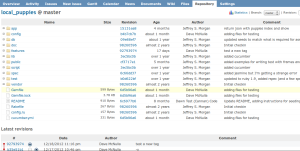Everywhere that I’ve ever worked at had a defect tracking system, requirements system, and sometimes merged into one. Some were off the shelf, some were homemade, and others were services. I never felt the need to install one for work, but I did want to see what was involved with doing this, including how to integrate it with other products in the test stack.
I didn’t look around much for an open source solution. I know Bugzilla is commonly used. I also looked at Mantis and Trac. I decided to go with Redmine because it’s a Ruby On Rails app.
Installation
The biggest issue was to identify which ports to use. I already had a Puppies application that I was testing as part of my Cucumber and Cheese book. I added a Graylog2 application, also Ruby On Rails for the web interface (server component is java).
I originally chose to use sqlite3 because it was already installed on my system. I knew that I could use IRB to crack into the database if I needed to. Turned out that I did. I had to create an admin user (default one did not work). I eventually switched to MySQL.
Integrations
I integrated it with Git. I had trouble getting it working until I discovered that I needed to point it to the .git directory of my project directory. By including issue id’s in my checking comments, the issue automatically associated the issue with the checkin. The comment showed up on the repository page and the issue page. It supports diffing, too.

I was able to install a Jenkins Plugin (technically it is for Hudson but works on Jenkins) to integrate with my Jenkins. This allowed me to identify which builds the associated checkins would be built. I also installed a Redmine plugin to Jenkins could also track builds on Jenkins to show Redmine issues associated with the build in aggregate.
It also supported multiple projects, and sub-projects. The wiki and news seemed relevant for keeping track of project information.
There is role based access control. That probably isn’t necessary for an agile team so I ignored this capability. Also non-agile (my opinion) is time tracking and Gantt charts.
Conclusion
I found all the features to be useful. If I were going to build my own stack then I would like using this component.

